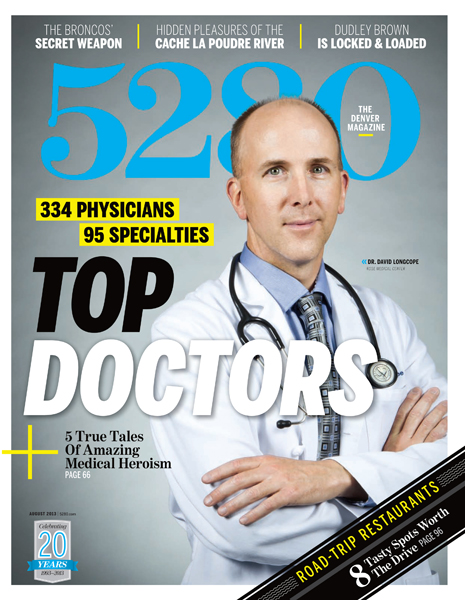The Local newsletter is your free, daily guide to life in Colorado. For locals, by locals.
Every two seconds in the United States, a patient receives a donated blood transfusion. Bonfils Blood Center helps fill that need in Denver. Founded in 1943 by Dr. Osgoode Philpott and Helen G. Bonfils, the nonprofit Bonfils Blood Center collects nearly 143,000 units of blood annually. In 2012, the organization supplied 99,290 units of blood to Colorado hospitals. Because whole blood expires after 42 days—platelets in just five—Bonfils strives to collect more than 3,000 units of blood every week (each person supplies one unit of blood per donation). This number was set to meet the blood supply needs at local hospitals and physicians’ offices while incorporating an emergency three-to-five-day supply for unforeseen incidents.
Thanks to this reserve, Bonfils was able to provide more than 350 units of blood in 12 hours to the five hospitals treating victims of the Aurora theater shooting. In the event of an incident—or in cases like C. Smith’s, a single patient—that may deplete the organization’s blood supply, Bonfils’ Appointment Center calls previous donors to request a donation while simultaneously increasing the number of blood drives held in surrounding communities. Bonfils is also the only Colorado member of America’s Blood Centers—a national network of 70 blood centers—which distributes donations to in-need centers during emergencies.
Can I donate?
Most likely, yes. Approximately 3.5 million Coloradans are eligible blood donors as defined by Bonfils’ blood donor eligibility requirements.
Eligible Donors…
>are at least 18 years old (or 16 with parental consent)
>are heavier than 115 pounds to donate blood (110 to donate platelets or plasma)
>haven’t donated whole blood in the past 56 days or platelets in the past 14 days
>have no history of HIV/AIDS
>are not pregnant
>haven’t traveled to a malarial-endemic area in the past 12 months
>are not taking any medications listed on Bonfils’ website
For a full list of eligibility requirements, visit bonfils.org.
How do I donate?
Eligible donors can give blood by visiting one of the six community donor centers (CDCs) or at a mobile blood drive. Go to bonfils.org to find a CDC or blood drive near you. Note: Scheduling an appointment before your visit is strongly encouraged. To make an appointment, call 303-363-2300.
_______
Recognizing A Heart Attack
Dr. Andrew Ziller had no family history of heart attack, which is why he was reluctant to believe his symptoms were indicative of the condition. As an ER doc, Ziller says he feels a little sheepish that he wasn’t able to self-diagnose—but symptoms vary widely and his weren’t necessarily typical. More than a year after his trip to the Rose emergency department, Ziller says his best advice is to never ignore the warning signs. “Don’t wait,” Ziller says. “Don’t lie down to take a nap, don’t go to lunch, don’t go to bed for the night. If I had waited any longer, I may not be here today.”
Ziller recommends calling 911 if you experience any combination of the following symptoms:
—Chest pain
—A sensation of pressure in the chest
—Left arm pain
—Cold sweats
— Shortness of breath
—Nausea
—Jaw pain
—Light-headedness
_______
How To Save A Limb
Dr. William Brown says that in his long career replanting extremities he has seen nearly everything when it comes to how people try to care for a severed part. In other words, he’s witnessed a variety of ways to do it wrong. Here, suggestions for preserving a body part for replantation.
Do
? Recover the part
? Rinse the part with clean water to remove dirt or contaminated fluid
? Wrap the part with sterile gauze moistened with water or saline solution
? Place the severed part in a sterile container
? Put the container on ice
? Get the part to medical personnel as quickly as possible
Don’t
? Place the part directly on ice
? Submerge the part in water
? Use dry ice
? Use any antiseptics or other medical products
_______
Outbreak
Just five months before Keona Hinkel arrived at Rocky Mountain Hospital for Children with an illness that only occurs about 90 times each year in the United States, seven-year-old Sierra Jane Downing of Pagosa Springs tested RMHC docs with an even rarer disease. Fever, vomiting, seizures, delirium, and hallucinations combined with a possible exposure to a dead squirrel led Dr. Jennifer Snow, Dr. Wendi Drummond, and Dr. Benjamin Ross to conclude that Downing was suffering from a case of…wait for it…bubonic plague.
Nationally, only about seven verified cases are seen each year—Downing was the first confirmed case of the Black Death in Colorado since 2005. After a round of intense antibiotics—modern medicine that wasn’t available when the plague killed 25 million people in the 14th century—Downing was discharged from the hospital. “I think what both of these cases illustrate—aside from the feel-good story of making a rare diagnosis, treating it effectively, and having a good outcome—and what I am most proud of,” Ross says, “is our team approach: the initial suspicion of our hospitalists and intensivists, who then contacted the specialists, the specialists working together, and everyone collaborating to come up with a plan for evaluation and ultimately diagnosis and treatment.”
_______
Diagnosis
An Alternative Explanation for SIDS?
Although there have been conflicting studies over the past 20 years, some doctors and researchers believe that a small percentage of cases of Sudden Infant Death Syndrome (SIDS) can be attributed to undiagnosed infant botulism. Because the early symptoms of the rare paralytic illness are often attributed to a cold or simply go unnoticed at first, a baby can be put down for a nap or for the night and stop breathing when the toxins begin affecting the respiratory musculature. “Regardless, infant botulism remains a known cause of infant morbidity,” Dr. Benjamin Ross says, “that may be preventable with certain precautions and treatable if diagnosed in a timely manner.”
Search our 2013 Top Doctors list here.
—Image courtesy of Shutterstock









